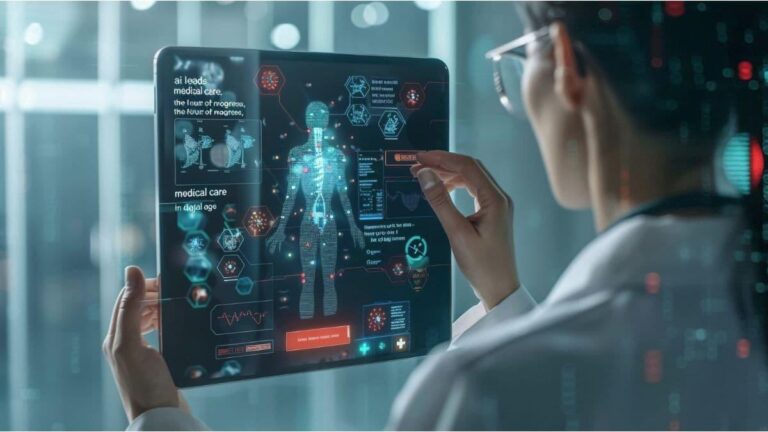In recent years, the integration of artificial intelligence (AI) into healthcare has ushered in a transformative wave of advancements, particularly in the realm of medical diagnostics. as healthcare systems worldwide grapple with escalating costs and the growing demand for high-quality care, AI diagnostics are emerging as a powerful tool to enhance efficiency and reduce expenses. By enabling faster, more accurate detection of diseases and streamlining clinical workflows, these bright technologies are not only improving patient outcomes but also significantly cutting operational costs. This article explores how AI diagnostics are reshaping the healthcare landscape, offering sustainable solutions that balance cost-effectiveness with superior diagnostic precision.
Table of Contents
- The Role of AI Diagnostics in Early Disease Detection and Prevention
- Enhancing Accuracy and Efficiency Through Machine Learning algorithms
- Reducing Operational Costs by streamlining Diagnostic Processes
- Implementing AI Solutions: Best Practices for Healthcare Providers
- In Retrospect
The Role of AI Diagnostics in Early Disease Detection and Prevention
Advancements in artificial intelligence have ushered in a new era for healthcare providers by enabling faster and more accurate diagnosis of diseases at their initial stages. AI diagnostic tools leverage vast datasets from medical imaging, genetics, and patient history to detect subtle patterns often missed by conventional methods. This rapid identification not only improves prognosis but also empowers physicians to initiate timely interventions. Consequently, patients experience fewer complications and reduced hospital stays, directly contributing to notable cost savings across the healthcare system.
Moreover, the integration of AI diagnostics strengthens preventive healthcare strategies through continuous monitoring and predictive analytics. Key benefits include:
- Early risk identification: AI algorithms forecast potential health issues before physical symptoms appear, allowing for proactive measures.
- Personalized treatment plans: By analyzing individual health data, AI aids in tailoring interventions that maximize effectiveness and minimize unneeded procedures.
- Resource optimization: Hospitals can allocate medical resources more efficiently,prioritizing high-risk patients and reducing redundant testing.
These capabilities collectively contribute to lowering healthcare costs while enhancing patient outcomes, demonstrating the profound impact of AI in reshaping modern medicine.
Enhancing Accuracy and Efficiency through Machine Learning algorithms
Machine learning algorithms have revolutionized the diagnostic process by enabling healthcare systems to analyze vast datasets with unprecedented precision. These algorithms learn from past medical records, imaging, and patient outcomes to identify patterns that may elude even the most experienced clinicians. This not only decreases the likelihood of human error but also accelerates the delivery of accurate diagnoses. As a result, healthcare providers can initiate targeted treatments earlier, improving patient prognosis while simultaneously reducing unnecessary expenditures on redundant or ineffective testing.
Key benefits include:
- Improved diagnostic accuracy through continuous learning and adaptation
- Streamlined workflows that minimize delays in clinical decision-making
- Cost savings by reducing redundant procedures and hospital readmissions
- Enhanced ability to personalize treatment plans based on predictive analytics
By embedding these intelligent systems within healthcare infrastructure, medical professionals are empowered to make data-driven decisions that optimize both patient care and operational efficiency. The synergy between human expertise and machine precision is setting a new standard, marking a pivotal shift towards smarter, economically sustainable healthcare delivery.
Reducing Operational Costs by streamlining Diagnostic processes
The integration of AI-powered diagnostic tools in healthcare settings has revolutionized the efficiency of identifying and interpreting medical conditions. By automating routine analysis tasks, healthcare professionals can significantly reduce the time and resources spent on diagnostics, leading to fewer unnecessary tests and faster patient throughput.This streamlined approach not only optimizes the workflow but also minimizes human error, delivering more accurate results swiftly. Hospitals and clinics witness reduced operational expenses as AI systems handle substantial portions of data processing, requiring less manual oversight and enabling personnel to focus on complex cases.
Key benefits of implementing AI diagnostics include:
- Lower labor costs through automation of repetitive tasks.
- Decreased diagnostic turnaround times facilitating earlier intervention.
- Reduced reliance on expensive imaging and testing procedures by prioritizing cases with AI risk assessment.
- Enhanced resource allocation by predicting patient needs with greater precision.
As healthcare systems adopt these innovative solutions, the cumulative effect is a substantial reduction in operational expenses — a critical factor in delivering sustainable, cost-effective care without compromising on quality.
Implementing AI Solutions: Best Practices for Healthcare Providers
Healthcare providers aiming to integrate AI diagnostics must prioritize a multidisciplinary collaboration approach. Combining the expertise of clinicians, data scientists, and IT specialists ensures the progress of solutions that are not only clinically accurate but also seamlessly operable within existing healthcare infrastructures. By fostering open dialog channels,institutions can address concerns around algorithm openness and data biases early in the deployment process. Moreover, aligning AI tools with regulatory standards and ethical frameworks is a critical step to maintain patient trust and ensure compliance with healthcare laws.
Best practices to consider include:
- conducting rigorous validation through diverse clinical trials to guarantee AI accuracy across patient demographics.
- implementing continuous monitoring systems to evaluate AI performance and promptly detect any deviations or errors.
- Prioritizing data security by adopting state-of-the-art encryption methods and anonymizing patient facts.
- Providing thorough training programs for healthcare staff to optimize AI integration and user experience.
In Retrospect
the integration of AI diagnostics into healthcare systems represents a pivotal advancement in reducing costs while maintaining, and often enhancing, the quality of patient care. By streamlining processes, minimizing errors, and enabling early detection, AI technologies are not only helping healthcare providers operate more efficiently but also making medical services more accessible and affordable for patients. As these technologies continue to evolve and gain wider adoption, they hold the promise of transforming healthcare economics on a global scale, ultimately contributing to a more sustainable and patient-centered future.

